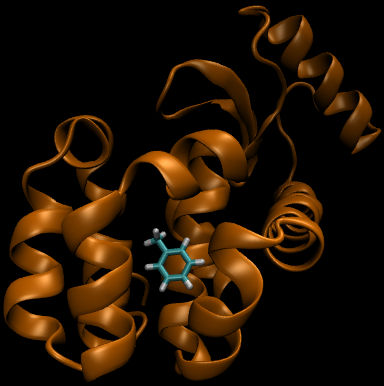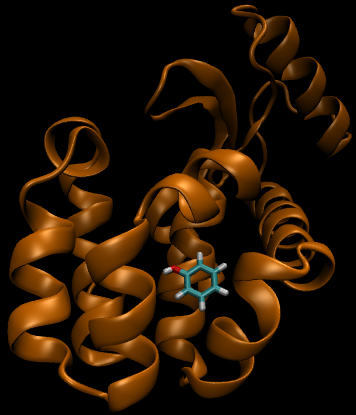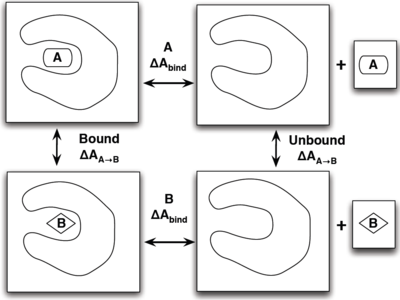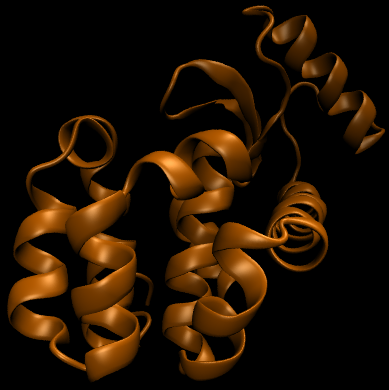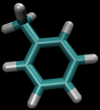Difference between revisions of "Example: Relative Binding Affinity"
| Line 49: | Line 49: | ||
=What are the End States?= | =What are the End States?= | ||
| + | There are two real end states we need here. Since the T4 lysozyme and solvent are not changing in either case, they will be present in both end states. | ||
| + | *''State A)'' T4 lysozyme in solvent with an intermediate molecule that looks like toluene in the pocket. | ||
| + | *''State B)'' T4 lysozyme in solvent with an intermediate molecule that looks like phenol in the pocket. | ||
| + | |||
| + | [[Image:Toluene_Phenol_Topology.png.png|right|thumb|300px|Different topology choices. Even though the intermolecular forces will be for the real atoms, there are still dummy intramolecular forces. Please see [[[[Intermediate_States#Topologies|the full page on topologies]] for a more in depth description.]] | ||
| + | What does it mean to have an "intermediate state look like" a molecule as an end state? This intermediate state could well be just toluene or phenol, however, there will still be the dummy atoms on it based on the [[Intermediate_States#Topologies|topology choice]]. Recall from the figure on the right that, even though the interacting molecule will be a physical molecule, there are still the dummy interactions that must be built in and considered. | ||
| + | |||
| + | For this example, a dual state topology is shown on the right, but it is by no means the only set of end states one could chose; an ''ortho-'' or ''meta-'' arrangement could just as easily be selected with the dual topology scheme. There is also not a limitation on just dual topologies as single topologies will also work in any of the arrangements. | ||
| + | |||
| + | Although beyond the scope of this example, it is also worth mentioning there is also research ongoing in predicting how a real molecule will behave and the end point will not have the full interactions of a real molecule, but some unphysical intermediate. The free energies of the real molecule are extrapolated from these results. This is particularly helpful for doing more than one transformation as you would not need a unique set of intermediate states for each pair of real molecule end points. | ||
| + | |||
=What are the [[Intermediate States]]?= | =What are the [[Intermediate States]]?= | ||
| + | For this example, we will assume that the phenol is the initial state, although we could have just as easily assumed it was the toluene. Observe that the OH moiety must disappear and the methyl must appear to make the transformation complete. A good first approach sample set of intermediates can be constructed that follow this process: | ||
| + | |||
| + | #Turn the charge on the OH and the ''para-'' hydrogen to zero. Recall it is important to [[Intermediate_States#Rules_of_Thumb_for_Intermediate_States|make sure the overall system is at the same total charge]] at each intermediate. | ||
| + | #Next, you will want to turn the Lennard-Jones CONTINUE HERE | ||
| + | |||
=What [[Simulating_States_of_Interest | Simulations to Run]]?= | =What [[Simulating_States_of_Interest | Simulations to Run]]?= | ||
=What [[Analyzing Simulation Results|Analysis do we Perform]]?= | =What [[Analyzing Simulation Results|Analysis do we Perform]]?= | ||
Revision as of 16:58, 10 October 2012
| Free Energy Fundamentals |
|---|
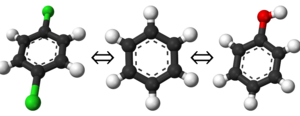 |
|
Methods of Free Energy Simulations
|
| Free Energy How-to's |
|---|
 |
This example will be a bit more complex than the solvation example since we are now transforming one molecule to another within an environment. Again, the purpose of this page is not to take you through step-by-step the process of simulation, but instead guide you through the logical decisions that can be applied to any simulation package of your choosing. We will work through the same questions that were asked on the previous example as these should be asked for any free energy simulation.
For this particular example, we will look at the difference in the relative binding free energies of toluene and phenol in the apolar cavity of T4 Lysozyme.

|
What is the Thermodynamic Cycle?
If you have already read through the thermodynamic cycle page, then you will have already seen this picture on the left. For our simulation, we can define the thermodynamic cycle either by directly converting toluene to phenol (which would be very costly due to the large number of changing interactions and box size), or we can recognize that free energy is a state function and we can use this relation to solve for it as well:
- [math]\displaystyle{ \Delta \Delta A_{\mathrm{bind}} = \Delta A_{\mathrm{bind}}^B - \Delta A_{\mathrm{bind}}^A = \Delta A_{A\rightarrow B}^{\mathrm{bound}} - \Delta A_{A\rightarrow B}^{\mathrm{unbound}} }[/math]
which does not require an excessively large box and can be done relatively simply by choosing the correct intermediate states to transform the ligands.
To provide the visuals for this particular system, please see the rendered images below; note that the solvent can be either implicit or explicit and the cycle will still be valid.
What are the End States?
There are two real end states we need here. Since the T4 lysozyme and solvent are not changing in either case, they will be present in both end states.
- State A) T4 lysozyme in solvent with an intermediate molecule that looks like toluene in the pocket.
- State B) T4 lysozyme in solvent with an intermediate molecule that looks like phenol in the pocket.
[[Image:Toluene_Phenol_Topology.png.png|right|thumb|300px|Different topology choices. Even though the intermolecular forces will be for the real atoms, there are still dummy intramolecular forces. Please see [[the full page on topologies for a more in depth description.]] What does it mean to have an "intermediate state look like" a molecule as an end state? This intermediate state could well be just toluene or phenol, however, there will still be the dummy atoms on it based on the topology choice. Recall from the figure on the right that, even though the interacting molecule will be a physical molecule, there are still the dummy interactions that must be built in and considered.
For this example, a dual state topology is shown on the right, but it is by no means the only set of end states one could chose; an ortho- or meta- arrangement could just as easily be selected with the dual topology scheme. There is also not a limitation on just dual topologies as single topologies will also work in any of the arrangements.
Although beyond the scope of this example, it is also worth mentioning there is also research ongoing in predicting how a real molecule will behave and the end point will not have the full interactions of a real molecule, but some unphysical intermediate. The free energies of the real molecule are extrapolated from these results. This is particularly helpful for doing more than one transformation as you would not need a unique set of intermediate states for each pair of real molecule end points.
What are the Intermediate States?
For this example, we will assume that the phenol is the initial state, although we could have just as easily assumed it was the toluene. Observe that the OH moiety must disappear and the methyl must appear to make the transformation complete. A good first approach sample set of intermediates can be constructed that follow this process:
- Turn the charge on the OH and the para- hydrogen to zero. Recall it is important to make sure the overall system is at the same total charge at each intermediate.
- Next, you will want to turn the Lennard-Jones CONTINUE HERE
